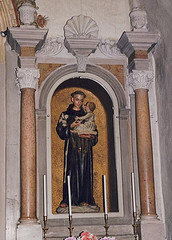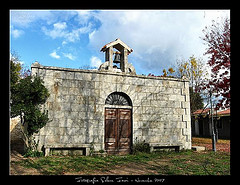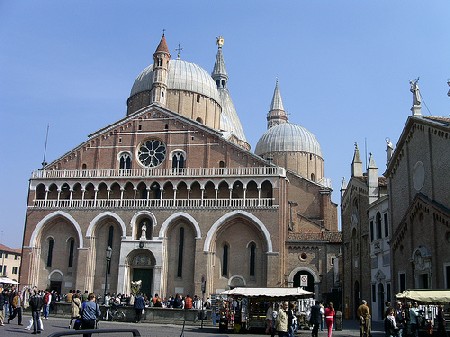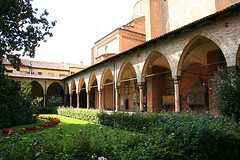 Retracing the steps of Saint Antonio and at the same time discovering treasures of inestimable value around his relics, or arriving in town to visit the art treasures and then find themselves immersed in a spiritual walk in the footsteps of a man of the’200, is an experience that only Padova can offer.
Retracing the steps of Saint Antonio and at the same time discovering treasures of inestimable value around his relics, or arriving in town to visit the art treasures and then find themselves immersed in a spiritual walk in the footsteps of a man of the’200, is an experience that only Padova can offer.
The itinerary in the footsteps of the Holy Saint start from the Sanctuary of Noce di Camposampiero. The legend tells that the church was built in the exact location where S. Antonio hold a memorable sermon from a walnut tree. There is a table of Andrea da Murano signed and dated in 1486 representing this episode. there also are frescoes evoking scenes of miracles and life of the saint, a work by Girolamo del Santo, painter of the’500.
After a long and fascinating journey in the high Padua countryside visitors reach the second station in a suburb of Padua, called “Arcella”.
Further down, at the intersection of Via T. Aspetti and Viale dell’Arcella the Shrine of St. Anthony marks the point where the carriage coming from Camposampiero, carrying the dead body of the Saint, turned towards the monastery of the poor women, known as the Sanctuary Antonianum. Here there is the Cella del Transito, where the Saint died on 13 June 1231.Then the path reaches the Sanctuary of the Arcella, near Padua.
Padua is reached through Porta Ponte Molino, as did the coffin of Saint Antonio on June 17, 1231.
Finally we comes in front of the massive Basilica of St. Antonio. The majestic building was built in 1232, one year after the death of the saint and consists of very different styles: Lombard, Tuscan and Byzantine style, while the 8 cupolas and the two bell towers are more oriental. Inside there is the Arca of the Saint with the tomb of St. Anthony.
The church has three naves, which are united in semi-circle behind the rostrum, where there are nine radial chapels, among which stands the Chapel of the Treasure or the Relics: here there is the incorrupt tongue of the Saint. In the northern aisle there is the Chapel of the Saint, work of A. Briosco and G. Falconetto where the Arca of Saint Antony is housed. Laterally there is the chapel dedicated to the Madonna Mora, a rest of the ancient church dedicated to St. Maria Mater Domini. Here there is the Chapel of Luca Belludi completely frescoed by Giusto de ‘Menabuoi (1382). The south aisle is enriched by the Chapel of St. Giacomo and S. Felice with the beautiful paintings by Altichiero Zevio (1374-78). The crucifix, the sculptures and the equestrian statue of Gattamelata on the apron are works by Donatello.
Beside the church there is the monastery with its beautiful cloisters, in the first of which grows an very old Magnolia. Facing Piazza del Santo we find the Oratorio of Sain Giorgio, chapel frescoed by Altichiero by Zevio (1379-1384), the Scuola del Santo, which was restored in 2006, also housing paintings by Titian, and the Antoniano Museum, which houses paintings, items of jewelry, vestments and sacred sculptures.
In remembrance of the death of the saint for centuries pilgrims and devotees retrace his final journey.
The credential is issued free by the Conventual Minor Franciscan Friars to pilgrims on foot, by bicycle or on horseback intending to make an authentic Christian pilgrimage along the step of the Saint.
The credential is designed to ensure the authenticity of the pilgrimage and to identify the pilgrim. It must reported stamps evidencing the steps in the three Antonian sanctuaries. The credential allows to receive, on behalf of the Rector of the Basilica del Santo, certification of the pilgrimage.
For more information, click here.
The Pilgrimage of Saint Anthony by Padua
Categories
- Abruzzo (11)
- Aosta Valley (4)
- Apulia (7)
- Basilicata (5)
- Calabria (5)
- Campania (31)
- Emilia Romagna (7)
- Friuli Venezia Giulia (4)
- Italy (292)
- Lazio (4)
- Liguria (22)
- Lombardy (23)
- Marche (6)
- Molise (1)
- Piedmont (12)
- Rome and Surrounding (64)
- Sardinia (8)
- Sicily (22)
- Trentino Alto Adige (8)
- Tuscany (90)
- Umbria (26)
- Valle d'Aosta (1)
- Veneto (35)
- Wordpress (5)


